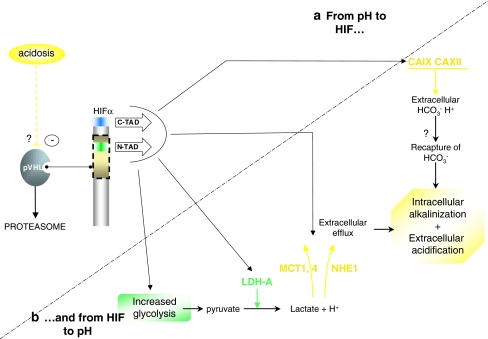Fig. 6.
From pH to HIF and from HIF to pH. a It has been proposed that acidosis could protect HIFα from proteasomal degradation by sequestering the component of the VHL E3 ubiquitin ligase complex in nucleoli. b HIF acts both directly and indirectly on the pH. On the one hand, by stimulating glycolysis (green) it favors the production of lactate and protons that could potentially acidify the intracellular medium. On the other hand HIF promotes intracellular alkalinization (yellow) by activating monocarboxylate transporter (MCT1, 4) and Na+/H+ exchanger (NHE1, 6) that are able to evacuate lactate and protons, respectively. Simultaneously, the membrane carbonic anhydrases (CA) CA IX and CA XII isoforms acidify the extracellular matrix by converting CO2 and H2O into HCO3- and H+. Our group hypothesizes that while protons acidify the extracellular medium, bicarbonate could be recaptured in order to alkalinize the cell. In summary HIF compensates for the intracellular production of lactic acid associated with anaerobic metabolism by a process of intracellular alkalinization that is linked to extracellular acidification

